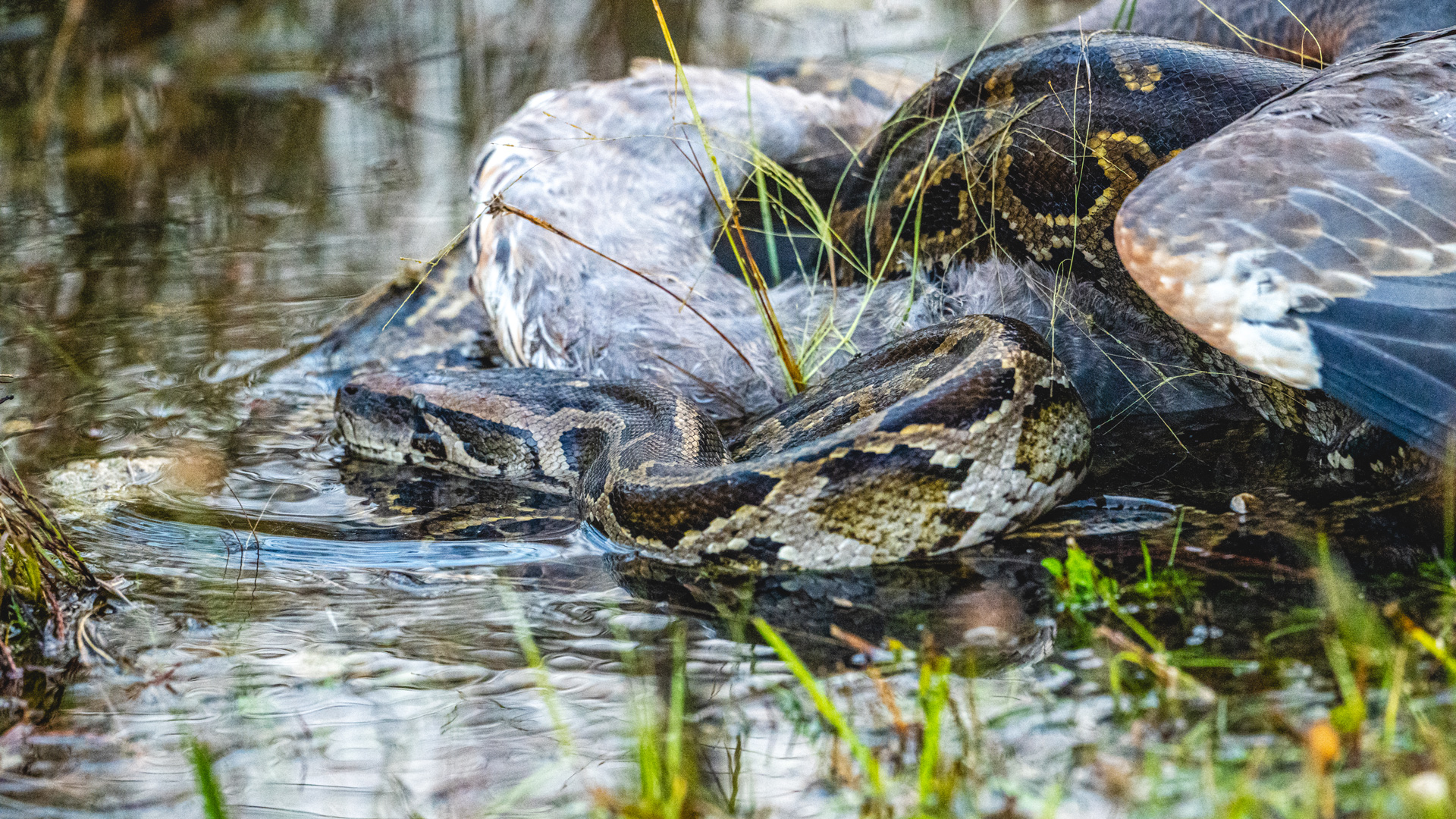
by Brian McCombie - Wednesday, July 16, 2025

At the 2025 Florida Python Challenge occurring right now, Florida snake hunters are searching the swamps and thick brush of the Florida Everglades to find and remove invasive Burmese pythons.
At stake: $25,000! Prizes include a $10,000 Ultimate Grand Prize for the removal of the most pythons during the competition. Participants also can “cash in” for the most and the longest pythons removed in three different categories, including novice, professional and military categories.
The Challenge began on Fri., July 11, and continues through 5 p.m. on Sun., July 20, at nine specific locations in Southern Florida.
Hosted by the Florida Fish and Wildlife Conservation Commission (FWC) and the South Florida Water Management District, the event aims to raise awareness about the threats posed by this invasive species. Prolific and very efficient hunters, Burmese pythons are entrenched residents of southern Florida now, and their growing numbers represent many problems for native wildlife species in the Sunshine State.
The sponsors of this year’s annual Python Challenge include three Platinum Level Sponsors: Inversa, Rotary Clubs of Florida and Mrs. Daphne and Mr. Martin C. Wood III, each of which donated $10,000. The three Gold Level Sponsors—Bergeron Everglades Foundation, Edison National Bank/Bank of the Islands and The Garcia Companies—added $5,000 apiece in support of conservation efforts through this event.
Native to India, lower China, the Malay Peninsula and some islands of the East Indies, Burmese pythons arrived in Florida during the 1970s as pets. According to WikiPedia, some people apparently found these slithery pets a little too much to handle and released them into the wilds. In 1992, Hurricane Andrew added to the problem by destroying a python breeding center, setting loose hundreds of the snakes.

One of the largest snakes in the world, adult Burmese pythons caught in Florida average between 6 and 9 feet in length. The largest Burmese captured in Florida measured more than 18 feet. According to the FWC, Burmese pythons are semi-aquatic and are often found in or near water—which explains why Florida populations of the snakes historically centered within Everglades National Park in Miami-Dade County.
But the snakes are travelers, too, and have established themselves from just south of Lake Okeechobee to Key Largo and from western Broward County west to Collier County.
Extremely prolific, a female Burmese python can lay 50 to 100 eggs at a time. More than 23,000 Burmese pythons have been removed from the state since 2000, though the population has only grown over the last two and a half decades, with the snakes expanding their reach, as noted, into other parts of Florida.
Burmese pythons are generalist predators. Species found in their gut contents during necropsies include a variety of mammals, birds, reptiles—and protected species such as the federally designated Threatened wood stork and the federally designated Endangered Key Largo woodrat.
Burmese pythons can consume meals equivalent to 100 percent of their body mass. USA Today reported on a 2012 study suggesting that in Everglades National Park alone, the hungry predators were responsible for a decline of 85 to 100 percent of the populations of rabbits, raccoons and other similar-sized animals.
Pythons may also prey upon cats and dogs, and even smaller deer are occasionally found in the stomachs of these snakes. Attacks on humans are very, very rare, but given their size, Burmese pythons can pose a threat to humans.
According to the Python Challenge rules, participants can’t use firearms to bag snakes. Challenge locations include Wildlife Management Areas, public hunting and wildlife viewing lands, and Everglades National Park. Legally speaking, none of these areas have established firearm seasons during the Challenge time period. The use of bait, chemicals, explosives, traps, smoke and motorized tools to capture pythons are also prohibited.
To take on their scaly prey, python hunters can use air guns, snake hooks, snake tongs, snake bags, noose poles and long-handled non-motorized tools to humanely remove or kill the snakes to help protect Florida’s unique ecosystems and native wildlife.
Last year’s 2024 Florida Python Challenge saw 857 participants from 33 states and Canada collectively remove 195 pythons. The Ultimate Grand Prize winner bagged 20 pythons and took home the $10,000.
But these events will not solve the problem in and of themselves. While it is incredibly difficult to estimate the true number of Burmese pythons in South Florida, one scientific estimate concluded that “tens of thousands” of the pythons live and reproduce in the Greater Everglades region.
So, does that estimate mean 30,000 Burmese pythons or 300,000 of them? No one knows for sure, and the Challenge is simply a means to get the word out on this huge and growing problem.
About the Author
Brian McCombie is a field editor for the NRA’s American Hunter and writes about firearms and gear for the NRA’s Shooting Illustrated. A member of the National Rifle Association and the National Shooting Sports Foundation, he enjoys hunting hogs, shooting 1911s, watching the Chicago Bears and relaxing with his two cats.
E-mail your comments/questions about this site to:
[email protected]
Proudly supported by The NRA Foundation and Friends of NRA fundraising.
